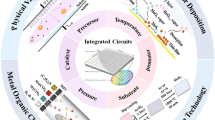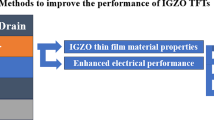Abstract
Metal oxide semiconductor (MOS) device down-scaling is a powerful driving force for the evolution of microelectronics. The downsizing rate of metal oxide semiconductor field effect transistors (MOSFETs) is really marvelous. Silicon dioxide (SiO2) has served as a perfect gate dielectric for the last four decades. Due to physical limitations, leakage current, high interface trap charge it now needs to be replaced with higher permittivity dielectric material. Keeping the motivation for the search of high-k materials, extensive studies have been carried out on several metal oxides, such as ZrO2, Ta2O5, TiO2, Al2O3 and HfO2 for the replacement of SiO2. The high dielectric constant (k) of titanium dioxide (TiO2) will open multifaceted prospects for the use of this material in microelectronic devices. In this paper, a comparative study of various deposition methods for fabrication of thin TiO2 films has been presented. This work uses a combination of simulation results, experimental data and critical analysis of published data. Further, an experiment using sol-gel method has been carried out to deposit thin films of TiO2. It has been characterized and compared with the earlier reported fabrication methods. The X-ray diffraction analyses and Raman spectra indicate the presence of anatase TiO2 phase in the film. The dielectric constant as calculated using capacitance-voltage (C-V) analysis was found to be 23. The refractive index of the film was 2.43. The TiO2 films studied for microelectronic applications and present acceptable properties such as low leakage current density of 1.0×10−5 A/cm at 1 V and band gap of 3.6 eV. The leakage current has been found to be dominant by the Schottky emission at lower electric field, while Flower-Nordheim (F-N) tunneling occurs at higher biasing voltages.
Similar content being viewed by others
References
Borkowska A, Domaradzki J, Kaczmarek D. Characterization of TiO2 and TiO2-HfO2 transparent thin films for microelectronics applications. In: 2006 International students and Young Scientist Workshop, Photonic and Microsystems. 2006: 5–8
Masuda Y, Jinbo Y, Yonzawa T, Koumoto K. Templeted site selective deposition of Titanium dioxide and self assembled monolayer. Chemistry of Materials, 2002, 14(3): 1236–1241
Fuyuki T, Matsunami H. Electronic properties of the interface between Si and TiO2 deposited at very low temperatures. Japanese Journal of Applied Physics, 1986, 25(9): 1288–1291
Su C, Hong B Y, Tseng CM. Sol-gel preparation and photocatalysis of titanium dioxide. Catalysis Today, 2004, 96(3): 119–126
Wong H, Iwai H. On the scaling issues and high-κ replacement of ultrathin gate dielectrics for nanoscale MOS transistors. Microelectronic Engineering, 2006, 83(10): 1867–1904
Gan J Y, Chang Y C, Wu T B. Dielectric property of (TiO2)x-(Ta2O5)1−x thin films. Applied Physics Letters, 1998, 72(3): 332
Westlinder J. Investigation of novel metal gate and high-k dielectric materials for CMOS technologies. PhD Thesis Uppsala: Acta Universitatis Upsaliensis, 2004: 8–72 www.uu.diva-portal.org/smash/get/diva2:165233/FULLTEXT01
Zhang L, Mu JM. Nanomaterial and Nanostructure. Bejing: Science Press, 2001
Kostlin H, Frank G, Hebbinghaus G, Auding H, Denissen K. Optical filters on linear halogen-lamps prepared by dip-coating. Journal of Non-Crystalline Solids, 1997, 218: 347–353
Corma A. From microporous to mesoporous molecular sieve materials and their use in catalysis. Chemical Reviews, 1997, 97: 2373–2420
Pomoni K, Vomvas A, Trapalis C. Transient photoconductivity of nanocrystalline TiO2 sol-gel thin films. Thin Solid Films, 2005, 479(1–2): 160–165
ITRS 2003, Edition, Semiconductor Industry Association (SIA), Austin, SEMATECH USA, 2706 from: www.itrs.net/links/2003
Kurakula S R. Studies on the electrical properties of titanium dioxide thin film dielectrics for microelectronic applications. Dissertation for the Master’s Degree. Indian Institute of Science, 2007: 1–45
Gusev E P, Cartier E, Buchanan D A, Gribelyuk M, Copel M, Okorn-Schmidt H, D’Emic C. Ultrathin high-K metal oxides on silicon: processing, characterization and integration issues. Microelectronic Engineering, 2001, 59(1–4): 341–349
Löbl P, Huppertz M, Mergel D. Nucleation and growth in TiO2 films prepared by sputtering and evaporation. Thin Solid Films, 1994, 251 (1): 72–79
Georgia J, Armynov S, Volva E, Oulios I P, Sotiropoulos S. Preparation and photoelectrochemical characterisation of electro-synthesised titanium dioxide deposits on stainless steel substrates. Electrochimica Acta, 2006, 51(10): 2076–2087
Battiston G A, Gerbai R, Porchia M, Margio A. Influence of substrate on structural properties of TiO2 thin films obtained via MOCVD. Thin Solid Films, 1994, 239(2): 186–191
Löbl H P, Huppertz M, Mergel D. ITO films for antireflective and antistatic tube coatings prepared by direct current magnetron sputtering. Surface and Coatings Technology, 1996, 82(1–2): 90–98
Meng L J, dos Santos M P. Investigations of titanium oxide films deposited by direct current reactive magnetron sputtering in different sputtering pressures. Thin Solid Films, 1993, 226(1): 22–29
Martin N, Rousselt C, Savll C, Palmino F. Characterizations of titanium oxide films prepared by radio frequency magnetron sputtering. Thin Solid Films, 1996, 287(1–2): 154–163
Fernandez L A, Espinos J P, Belderrain T R, Gonzalez-Elipe A R. Ion beam induced chemical vapor deposition procedure for the preparation of oxide thin films. II. Preparation and characterization of AlxTiyOz thin films. Journal of Vacuum Science and Technology A: Vacuum, Surfaces, and Films, 1996, 14(5): 2842–2848
Liu H M, Yang W S, Ma Y, Cao Y A, Yao J N, Zhang J, Hu T D. Synthesis and characterization of titania prepared by using a photoassisted Sol-Gel method. Langmuir, 2003, 19(7): 3001–3005
Chowdhury P, Barshilia Harish C, Selvakumar N, Deepthi B, Rajam K S, Chaudhuri A R, Krupanidhi S B. The structural and electrical properties of TiO2 thin films prepared by thermal oxidation. Physica B, Condensed Matter, 2008, 403(19–20): 3718–3723
Hitchman M L, Tian F. Studies of TiO2 thin films prepared by chemical vapour deposition for photocatalytic and photoelectrocatalytic degradation of 4-chlorophenol. Journal of Electroanalytical Chemistry, 2002, 538-539: 165–172
Kaliwoh N, Zhang J Y, Boyd I W. Characterisation of TiO2 deposited by photo-induced chemical vapour deposition. Applied Surface Science, 2002, 186(1–4): 241–245
Babelon P, Dequiedt A S, Mostéfa-Sba H, Bourgeois S, Sibillot P, Sacilotti M. SEM and XPS studies of titanium dioxide thin films grown by MOCVD. Thin Solid Films, 1998, 322(1–2): 63–67
Chakraborty S, Bera M K, Bhattachary S, Maiti C K. Current conduction mechanism in TiO2 gate dielectrics. Microelectronic Engineering, 2005, 81: 188–193
Chong L H, Malik K, de Groot C H, Kersting R. The structural and electrical properties of thermally grown TiO2 thin films. Journal of Physics Condensed Matter, 2006, 18(2): 645
Sze S M. Physics of Semiconductor Devices. New York: Wiley-Interscience, 1969, 496
Dalapati G K, Chatteraje S, Shrama S K, Nandi S K, Bose P K, Varma S, Patil S, Maiti C K. Electrical properties of ultrathin TiO2 films on Si1−yCy heterolayers. Solid-State Electronics, 2003, 47(10): 1793–1798
Zhang X W, Han G R. Microporous textured titanium dioxide films deposited at atmospheric pressure using dielectric barrier discharge assisted chemical vapor deposition. Thin Solid Films, 2008, 516 (18): 6140–6144
Ivan H, Pullmannov A, Martin P, Juraj H, Kups T, Spiess L. Communications structural and morphological investigations of TiO2 sputtered thin films. Communications, 2009, 60(6): 354–357
Bendavid A, Martin P J, Takikawa H. Deposition and modification of titanium dioxide thin films by filtered arc deposition. Thin Solid Films, 2000, 360(1–2): 241–249
Ohsaka T, Izumi F, Fujiki Y. Raman spectrum of anatase, TiO2. Journal of Raman Spectroscopy, 1978, 7(6): 321–324
Vigil E, Saadoun L, Ayllón J A, Domènechc X, Zumetaa I, Rodríguez-Clemente R. TiO2 thin film deposition from solution using microwave heating. Thin Solid Films, 2000, 365(1): 12–18
Rathee D, Kumar M, Arya S K. CMOS Development optimization, scaling issue and replacement with high-k material for future microelectronics. International Journal of Computer Application, 2010, 8(5): 10–17
Zhang H Z, Banfield J F. Understanding polymorphic phase transformation behavior during growth of nanocrystalline aggregates: insights from TiO2. Journal of Physical Chemistry B, 2000, 104(15): 3481–3487
Rathee D S, Sharma R, Pandey M. The Roadmap for CMOS scaling and optoelectronics devices. In: Proceedings of National Conference ITM. 2007, 82–87
Jang H D, Kim S K, Kim S J. Effect of particle size and phase composition of titanium dioxide nanoparticles on the photocatalytic properties. Journal of Nanoparticle Research, 2001, 3(2–3): 141–147
Author information
Authors and Affiliations
Corresponding author
Rights and permissions
About this article
Cite this article
Rathee, D., Arya, S.K. & Kumar, M. Analysis of TiO2 for microelectronic applications: effect of deposition methods on their electrical properties. Front. Optoelectron. China 4, 349–358 (2011). https://doi.org/10.1007/s12200-011-0188-z
Received:
Accepted:
Published:
Issue Date:
DOI: https://doi.org/10.1007/s12200-011-0188-z




